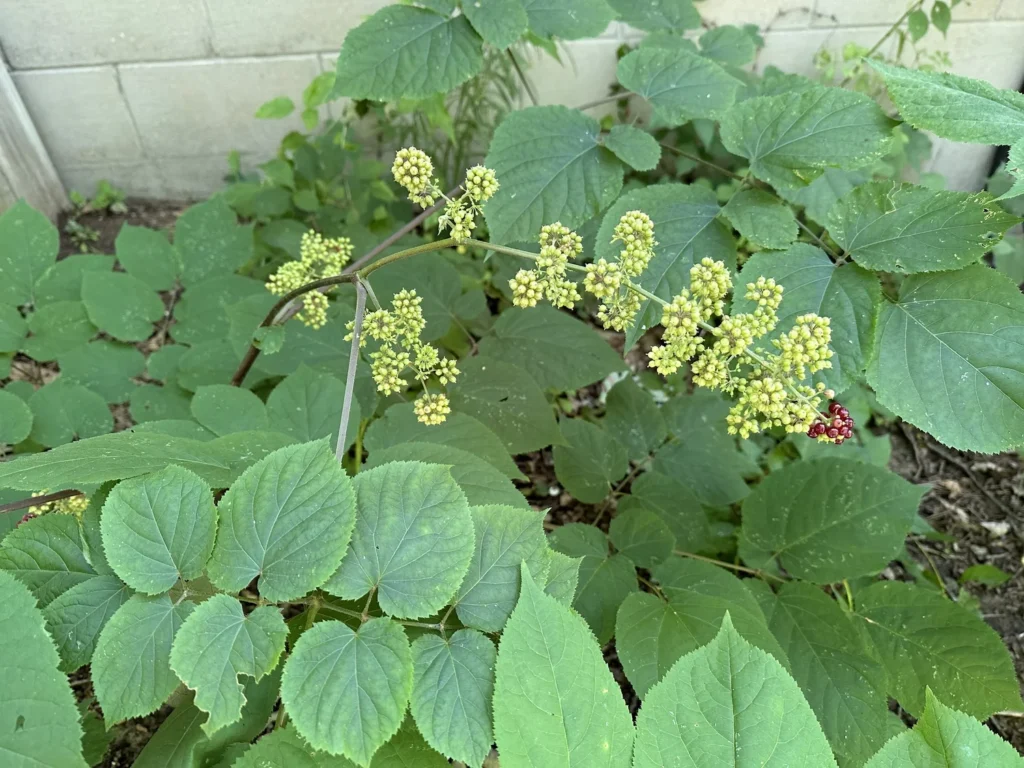
Aralia racemosa
Latin name: Aralia racemosa
Short name: Aral
Common name: American Spikenard | Spikenard | Life-of-Man | Pettymorel | Wild Elder
Primary miasm: Tubercular Secondary miasm(s): Sycotic
Kingdom: Plants
Family: Araliaceae
- Symptomatology
- Remedy Information
- Differentiation & Application
Aralia racemosa is a perennial herb native to North America, particularly abundant in the eastern United States and parts of Canada. Belonging to the Araliaceae family, it grows in rich woodlands and produces large clusters of aromatic roots. In herbal medicine, the root is noted for its warming, expectorant, and diaphoretic properties. The homeopathic remedy is prepared from the fresh root before flowering, macerated in alcohol.
Traditionally used by Native American tribes as a remedy for coughs, colds, rheumatism, and skin eruptions. In herbalism, it has been valued as a warming expectorant for chronic bronchitis, asthma, and as a tonic for convalescence. Roots were also infused to treat menstrual irregularities and promote perspiration during fevers.
First introduced into homeopathy by Dr. E. M. Hale, with provings conducted in the United States in the late 19th century. Symptomatology was further confirmed clinically in respiratory and asthmatic cases.
- Respiratory tract, especially larynx, trachea, and bronchi, with marked nocturnal aggravations.
- Lungs, particularly right upper lobe and apical regions, with tubercular tendencies.
- Mucous membranes of the upper respiratory passages.
- Skin, with pruritic and inflammatory eruptions.
- Nervous system via reflex spasms of respiration from laryngeal irritation.
- Sitting upright or leaning forward to ease breathing.
- Early part of the night before midnight.
- Mild, open air with moderate warmth.
- Lying down, particularly soon after retiring to bed, with sudden attacks of asthma.
- After first falling asleep.
- Warm, close rooms and hot weather.
- After exposure to damp night air.
- Onset of cold, especially in late summer and autumn.
- Sambucus nigra – Also has asthma after first sleep, but attacks are more associated with nasal obstruction in children.
- Spongia tosta – Cough after sleep, but more croupy, dry, with “sawing” respiration and without the characteristic throat-pit tickling.
- Arsenicum album – Asthma after midnight with great restlessness, but more gradual onset rather than sudden waking soon after sleep.
- Grindelia robusta – Asthma with inability to breathe lying down, but with more frothy mucus and easier expectoration.
- Complementary: Phosphorus, Sambucus nigra.
- Antidotes: Nux vomica, Ipecacuanha.
- Inimical: None recorded.
- Follows well: Sambucus, Grindelia.
Aralia racemosa embodies the picture of sudden, violent nocturnal asthma, marked by an almost clock-like precision in its occurrence soon after the patient falls asleep. The essence is one of vulnerability to night air and positional change, with reflex irritation of the larynx producing intense coughing and suffocation. It suits tubercular, nervous constitutions who are fine during the day but dread the night’s inevitable struggle for breath.
Particularly suited to asthma and bronchial irritation in late summer and early autumn. A valuable intercurrent for patients who suffer yearly at the same time, often in August or September. Useful in coughs from laryngeal irritation following damp night air exposure. Often acts best in the 3rd to 6th potency, though higher potencies may be indicated in purely reflex cough cases.
Mind
- Anxiety on going to bed from anticipation of asthma attacks.
- Restlessness from difficulty breathing.
Head
- Congestion of head during cough.
- Headache from coughing.
Eyes
- Lachrymation from cough.
- Eyes suffused during suffocative paroxysm.
Stomach
- Nausea from violent coughing.
- Retching with cough.
Skin
- Itching eruptions in tubercular constitutions.
- Skin symptoms alternating with asthma.
Extremities
- Cold hands during attacks.
- Numbness of fingers from poor oxygenation.
Generalities
- Asthma after first sleep.
- Worse lying down; better sitting up.
Hering – The Guiding Symptoms of Our Materia Medica: Detailed respiratory and nocturnal aggravation symptoms.
Clarke – A Dictionary of Practical Materia Medica: Clinical confirmations of nocturnal asthma and throat-pit tickling.
Hale – New Remedies: Historical introduction and proving notes.
Allen, T. F. – Encyclopedia of Pure Materia Medica: Primary proving symptoms.
Boericke – Pocket Manual of Homœopathic Materia Medica: Keynotes of nocturnal asthma after first sleep.
